The 11th SHARP Progress meeting took place on 9th November, 2023.
Category: Uncategorized
New Publication: “Jitter Radiation as an Alternative Mechanism for the Nonthermal X-Ray Emission of Cassiopeia A” by Emanuele Greco et al.
Synchrotron radiation from relativistic electrons is usually invoked as responsible for the nonthermal emission observed in supernova remnants. Diffusive shock acceleration is the most popular mechanism to explain the process of particles acceleration and within its framework a crucial role is played by the turbulent magnetic field. However, the standard models commonly used to fit X-ray synchrotron emission do not take into account the effects of turbulence in the shape of the resulting photon spectra. An alternative mechanism that properly includes such effects is the jitter radiation, which provides for an additional power law beyond the classical synchrotron cutoff. We fitted a jitter spectral model to Chandra, NuSTAR, SWIFT/BAT, and INTEGRAL/ISGRI spectra of Cassiopeia A (Cas A) and found that it describes the X-ray soft-to-hard range better than any of the standard cutoff models. The jitter radiation allows us to measure the index of the magnetic turbulence spectrum νB and the minimum scale of the turbulence  across several regions of Cas A, with best-fit values νB ∼ 2 − 2.4 and
across several regions of Cas A, with best-fit values νB ∼ 2 − 2.4 and  km.
km.

Full Article:
Greco, E. (SHARP), Vink, J. (SHARP), Ellien, A. (SHARP) and Ferrigno, C. (2023). Jitter Radiation as an Alternative Mechanism for the Nonthermal X-Ray Emission of Cassiopeia A. The Astrophysical Journal, 956, doi: 10.3847/1538-4357/acf567
License: CC BY 4.0
SHARP Progress meeting
The 10th SHARP Progress meeting took place on 18th September, 2023.
New Publication: “Electron heating in shocks: Statistics and comparison” by Michael Gedalin et al.
Supernova remnant (SNR) shocks are the highest Mach number non-relativistic shocks in electron-ion plasmas. These shocks are the most efficient particle accelerators in space. SNR shock parameters are inferred from measurements of electromagnetic radiation from heated and accelerated particles. Temperature of the shock heated electrons is one of the most important parameters in supernova remnant shocks. Knowledge of the downstream electron-to-ion temperature ratio or of the ratio of the downstream electron temperature to the incident ion energy is crucial for understanding physics of the very high-Mach number SNR shocks. Heliospheric shocks have substantially lower Mach numbers than SNR shocks but can be extensively studied in in situ observations with further extrapolation of the findings to higher Mach numbers. Magnetospheric Multiscale mission observations of the Earth bow shock are used to analyze dependence of the electron heating on the shock Mach number. It is found that the ratio of the downstream electron temperature to the incident ion energy decreases with the increase of the Mach number. At high Mach numbers this ratio and stabilizes at about 2.5%. The electron-to-ion temperature ratio stabilizes at about 10%. The peak electron temperature occurs at the overshoot maximum, further downstream electrons cool down. The mean ratio of the 4.5 s averages of the downstream and maximum electron temperatures is 0.85. Electron heating does not follow the thermodynamic adiabatic law. The heating and cooling behavior implies that the energy is provided by the overall cross-shock potential while small-scale electric fields rapidly isotropize the electron distribution.
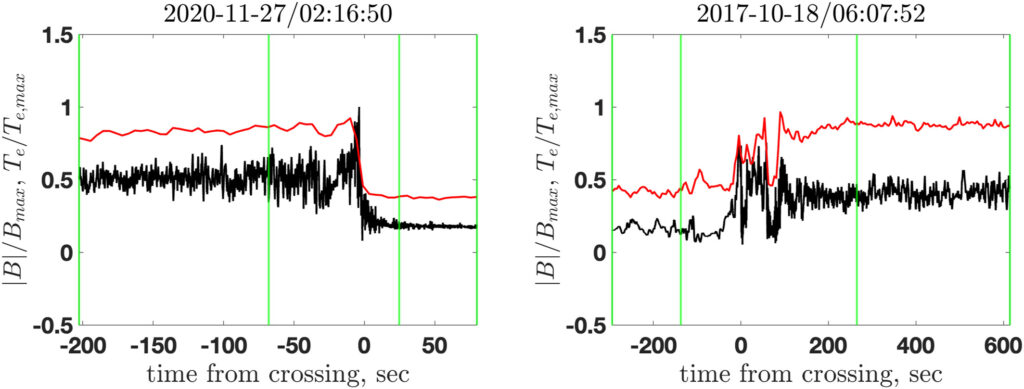
Full Article:
Gedalin, M. (SHARP), Golan, M., Vink, J. (SHARP), Ganushkina, N. (SHARP), & Balikhin, M. (2023). Electron heating in shocks: Statistics and comparison. Journal of Geophysical Research: Space Physics, 128, doi: 10.1029/2023JA0316
License: CC BY-NC-ND 4.0
SHARP Summer School on Collisionless Shocks in Space, August 21-25, 2023
In August, the SHARP consortium organised a summer school on collisionless shocks in space in Levi, Finland. In total 23 students from more than 10 different countries attended the school. The lectures covered all research areas of the SHARP project, including basic theory on collisionless shocks, heliospheric shocks and astrophysical shocks. The students also attended exercise sessions where they learned about data analysis of shocks and the computation of basic shock parameters.
The program of the summer school can be found here.

New Publication: “Evidence for Thermal X-Ray Emission from the Synchrotron-dominated Shocks in Tycho’s Supernova Remnant” by Amaël Ellien et al.
Young supernova remnant (SNR) shocks are believed to be the main sites of galactic cosmic-ray production, showing X-ray synchrotron-dominated spectra in the vicinity of their shock. While a faint thermal signature left by the shocked interstellar medium (ISM) should also be found in the spectra, proofs for such an emission in Tycho’s SNR have been lacking. We perform an extended statistical analysis of the X-ray spectra of five regions behind the blast wave of Tycho’s SNR using Chandra archival data. We use Bayesian inference to perform extended parameter space exploration and sample the posterior distributions of a variety of models of interest. According to Bayes factors, spectra of all five regions of analysis are best described by composite three-component models taking nonthermal emission, ejecta emission, and shocked ISM emission into account. The shocked ISM stands out the most in the northern limb of the SNR. We performed an extended analysis of the northern limb and show that the measured synchrotron cutoff energy is not well constrained in the presence of a shocked ISM component. Such results cannot currently be further investigated by analyzing emission lines in the 0.5–1 keV range, because of the low Chandra spectral resolution in this band. We show with simulated spectra that Athena X-ray Integral Field Unit future performances will be crucial to address this point.
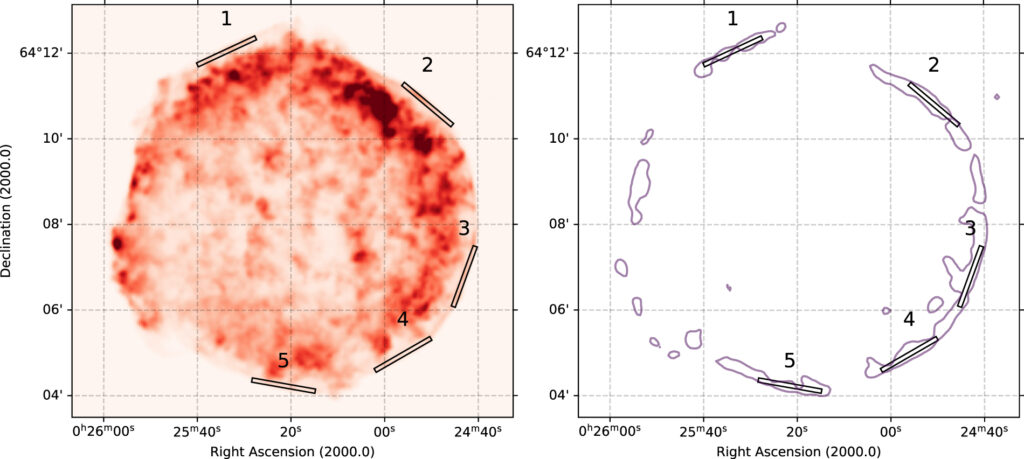
Full Article:
Ellien, A. (SHARP), Greco, E. (SHARP) and Vink, J. (SHARP) (2023). Evidence for Thermal X-Ray Emission from the Synchrotron-dominated Shocks in Tycho’s Supernova Remnant. The Astrophysical Journal, 951, doi: 10.3847/1538-4357/accc85
License: CC BY 4.0
New Publication: “Scattering of Ions at a Rippled Shock” by Michael Gedalin et al.
In a collisionless shock the energy of the directed flow is converted to heating and acceleration of charged particles, and to magnetic compression. In low-Mach number shocks the downstream ion distribution is made of directly transmitted ions. In higher-Mach number shocks ion reflection is important. With the increase of the Mach number, rippling develops, which is expected to affect ion dynamics. Using ion tracing in a model shock front, downstream distributions of ions are analyzed and compared for a planar stationary shock with an overshoot and a similar shock with ripples propagating along the shock front. It is shown that rippling results in the distributions, which are substantially broader and more diffuse in the phase space. Gyrotropization is sped up. Rippling is able to generate backstreaming ions, which are absent in the planar stationary case.
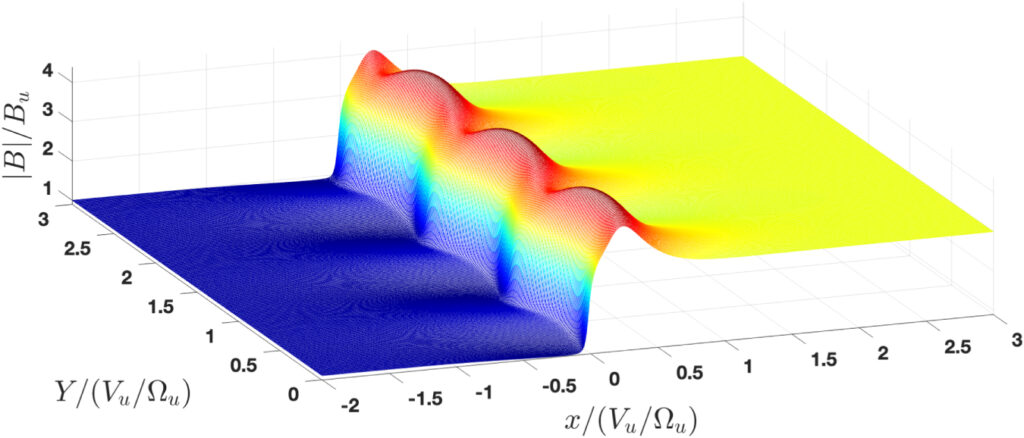
Full Article:
Gedalin, M. (SHARP), Pogorelov, N. V. and Roytershteyn, V. (2023). Scattering of Ions at a Rippled Shock. The Astrophysical Journal, 951, doi: 10.3847/1538-4357/acd63c
License: CC BY 4.0
New Publication: “Investigating the Time Evolution of the Thermal Emission from the Putative Neutron Star in SN 1987A for 50+ Years” by Akira Dohi, Emanuele Greco et al.
Observations collected with the Atacama Large Millimeter/submillimeter Array (ALMA) and analysis of broadband X-ray spectra have recently suggested the presence of a central compact object (CCO) in SN 1987A. However, no direct evidence of the CCO has been found yet. Here we analyze Chandra X-ray observations of SN 1987A collected in 2007 and 2018, and synthesize 2027 Chandra and 2037 Lynx spectra of the faint inner region of SN 1987A. We estimate the temporal evolution of the upper limits of the intrinsic luminosity of the putative CCO in three epochs (2018, 2027, and 2037). We find that these upper limits are higher for higher neutron star (NS) kick velocities due to increased absorption from the surrounding cold ejecta. We compare NS cooling models with both the intrinsic luminosity limits obtained from the X-ray spectra and the ALMA constraints with the assumption that the observed blob of SN 1987A is primarily heated by thermal emission. We find that the synthetic Lynx spectra are crucial to constrain the physical properties of the CCO, which will be confirmed by future observations in the 2040s. We draw our conclusions based on two scenarios, namely the nondetection and detection of the NS by Lynx. If the NS is not detected, its kick velocity should be ≃700 km s−1. Furthermore, nondetection of the NS would suggest rapid cooling processes at the age of 40 yr, implying strong crust superfluidity. Conversely, in the case of NS detection, the mass of the NS envelope must be high.
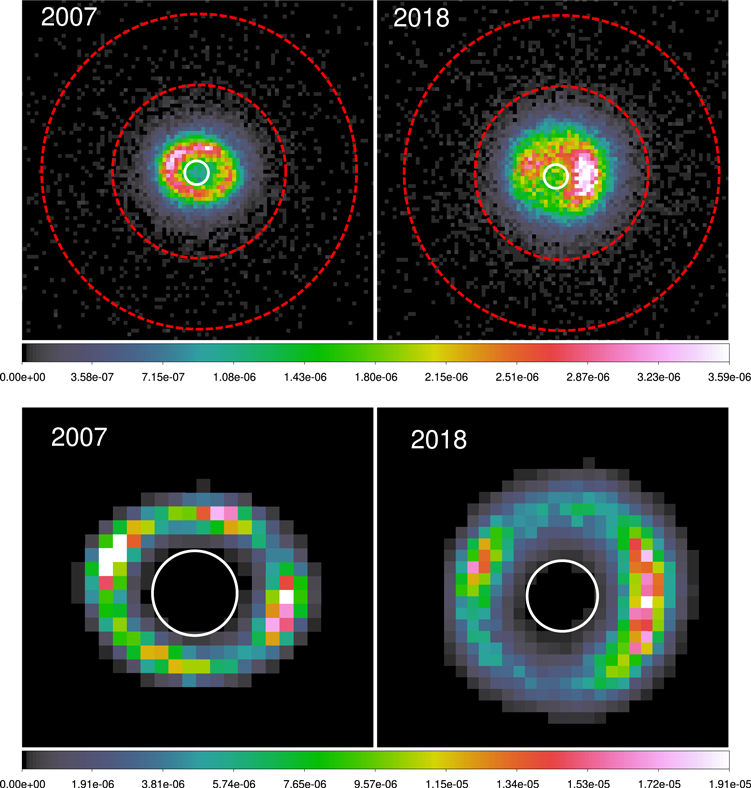
Full Article:
Dohi, A., Greco, E. (SHARP), Nagataki, S., Ono, M., Miceli, M., Orlando,S. and Olmi, B. (2023). Investigating the Time Evolution of the Thermal Emission from the Putative Neutron Star in SN 1987A for 50+ Years. The Astrophysical Journal, 949, doi: 10.3847/1538-4357/acce3
License: CC BY 4.0
New Publication: “Role of the overshoot in the shock self-organization” by Michael Gedalin et al.
A collisionless shock is a self-organized structure where fields and particle distributions are mutually adjusted to ensure a stable mass, momentum and energy transfer from the upstream to the downstream region. This adjustment may involve rippling, reformation or whatever else is needed to maintain the shock. The fields inside the shock front are produced due to the motion of charged particles, which is in turn governed by the fields. The overshoot arises due to the deceleration of the ion flow by the increasing magnetic field, so that the drop of the dynamic pressure should be compensated by the increase of the magnetic pressure. The role of the overshoot is to regulate ion reflection, thus properly adjusting the downstream ion temperature and kinetic pressure and also speeding up the collisionless relaxation and reducing the anisotropy of the eventually gyrotropized distributions.
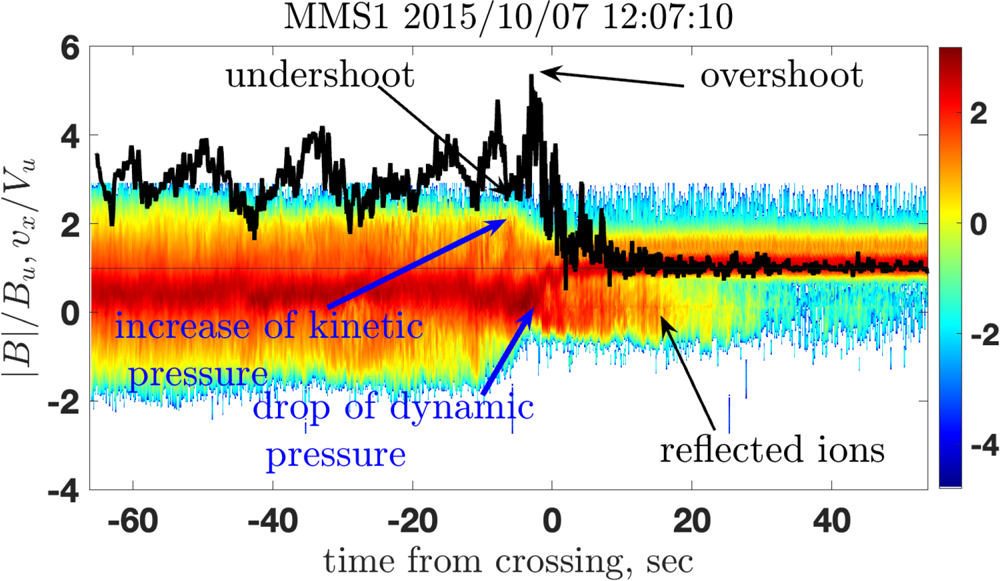
Full Article:
Gedalin, M. (SHARP), Dimmock, A. (SHARP), Russell, C. (SHARP), Pogorelov, N., & Roytershteyn, V. (2023). Role of the overshoot in the shock self-organization. Journal of Plasma Physics, 89(2), doi: 10.1017/S0022377823000090
License: CC BY 4.0
New Publication: “X-Ray Polarimetry Reveals the Magnetic-field Topology on Sub-parsec Scales in Tycho’s Supernova Remnant” by Riccardo Ferrazzoli et al.
Supernova remnants are commonly considered to produce most of the Galactic cosmic rays via diffusive shock acceleration. However, many questions regarding the physical conditions at shock fronts, such as the magnetic-field morphology close to the particle acceleration sites, remain open. Here we report the detection of a localized polarization signal from some synchrotron X-ray emitting regions of Tycho’s supernova remnant made by the Imaging X-ray Polarimetry Explorer. The derived degree of polarization of the X-ray synchrotron emission is 9% ± 2% averaged over the whole remnant, and 12% ± 2% at the rim, higher than the value of polarization of 7%–8% observed in the radio band. In the west region, the degree of polarization is 23% ± 4%. The degree of X-ray polarization in Tycho is higher than for Cassiopeia A, suggesting a more ordered magnetic field or a larger maximum turbulence scale. The measured tangential direction of polarization corresponds to the radial magnetic field, and is consistent with that observed in the radio band. These results are compatible with the expectation of turbulence produced by an anisotropic cascade of a radial magnetic field near the shock, where we derive a magnetic-field amplification factor of 3.4 ± 0.3. The fact that this value is significantly smaller than those expected from acceleration models is indicative of highly anisotropic magnetic-field turbulence, or that the emitting electrons either favor regions of lower turbulence, or accumulate close to where the orientation of the magnetic field is preferentially radially oriented due to hydrodynamical instabilities.
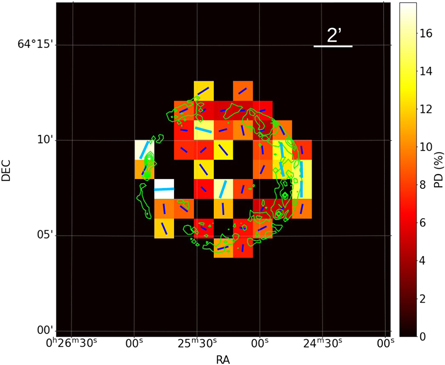
Full Article:
Ferrazzoli, R., Slane, P., Prokhorov, D. (SHARP), Zhou, P., Vink, J. (SHARP), et al. (2023). X-Ray Polarimetry Reveals the Magnetic-field Topology on Sub-parsec Scales in Tycho’s Supernova Remnant. The Astrophysical Journal, 945, doi: 10.3847/1538-4357/acb496
License: CC BY 4.0





